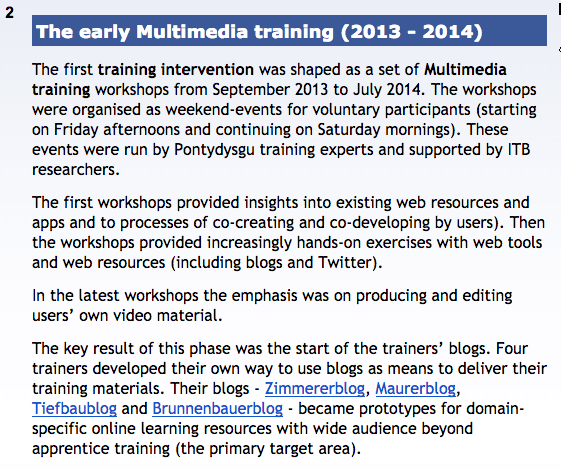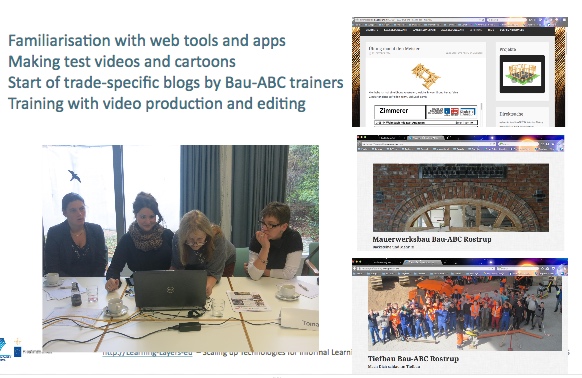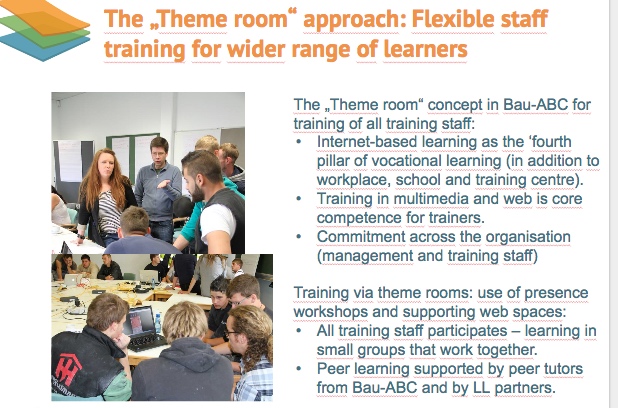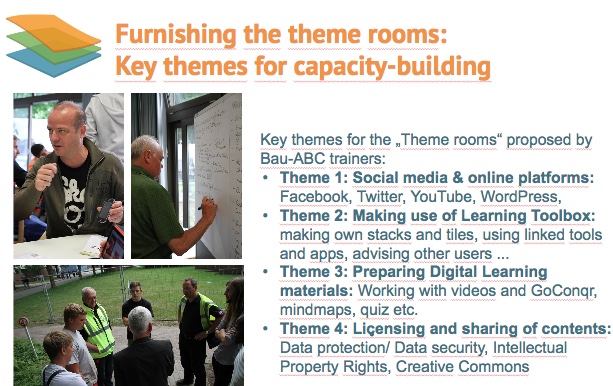Training Interventions as Capacity-Building for Digital Transformation in Vocational Education and Training (Training Centre Bau-ABC as an Example)
Highlights
This document provides insights into the role of training interventions as support for co-design processes and related research & development (R&D) dialogue in the construction pilot. The following developments are highlighted:
-
The training interventions were introduced as a process innovation alongside and within the co-design (not as a finalised ‘method’ to be implemented).
-
The early Multimedia training activities were introduced as a separate initiative, but gradually they became an important support for refocusing the co-design process.
-
The Theme Room training campaign became a ‘whole organisation initiative’ and paved the way to use the Learning Toolbox (LTB) in the apprentice training projects of Bau-ABC in different trades.
-
The Theme Room concept was proposed for a longer training campaign with more features. The documentation of the concept and use of materials (in Moodle) makes it possible to customise the approach (including the use of the LTB as a specific theme for training and tool for learning).
Background
As has been indicated in the parallel document “Accompanying Research and Participative Design in the Construction Pilot in Germany” (see Accompanying Research and Participative Design), it took some time and several iterations to get the design idea of Learning Toolbox shaped. This shaping process was a joint search process - involving research partners, technical partners and application partners in several iterations. In this way the process resembled the “Social shaping of work and technology” projects of the late 1990s (accompanied by ITB) and the “ICT and SMEs” projects between 2000 and 2004 (analysed by Pontydysgu). The common conclusion of these earlier project generations was that innovations of new technologies have to be shaped as socio-technical innovations and the the users have to find their own ways to become change agents and promoters of innovations.
This conclusion was very strongly confirmed by the later European projects for “Teachers’ Aids on Creating Content for Learning Environments” (TACCLE and TACCLE2). These projects developed a combined approach in which
-
the primary task of the project - preparation of a European e-learning handbook for teachers - was combined with a corollary task
-
organisation of training activities that enabled teachers to find their own ways to use digital media and web resources in their teaching.
In the beginning phase of the Learning Layers project it was easy to reach an agreement that one of the design ideas to be pursued should be the digitisation of the training and learning processes in the training centre Bau-ABC Rostrup. However, the co-design process turned out to be very complex. Therefore, the research partners (ITB), technical partners (Pontydysgu) and application partners (Bau-ABC) agreed that there is a need to launch a parallel learning process to raise awareness of existing tools and apps as well as on their usability in construction work and vocational learning. This provided the basis for the training interventions of the Learning Layers project alongside the co-design process.
Training interventions as shared learning opportunities
In the light of the above the training interventions were introduced firstly as ad hoc measures to support the co-design process. Firstly, they were planned as awareness-raising events with practical tasks to consolidate learning gains. Then, after a short interim period the Bau-ABC trainers prepared a new initiative that aimed to raise the user-competences of the entire training staff to a new level. Looking back, this process can be reconstructed as two phases of training interventions with an interim phase, during which the initiative shifted from the research and technology partners to the application partners. Below, the key activities of these phases are summarised briefly (and discussed in more detail in the next subsection):
-
The early phase of Multimedia Training (2013-2014) involved several interested Bau-ABC trainers and familiarised them with basic web tools and helped them to create their own multimedia content. The first sessions provided insights into a wide range of web tools and processes of using, co-developing apps and co-creating contents. The later sessions helped the trainers to create their own blogs and produce video material.
-
In the interim phase (2014) the Bau-ABC trainers started a pattern to organise internal meetings and informal learning sessions on using social media and on web resources. Whilst this was a necessary step to take the ownership of one’s own learning, these sessions did not involve many trainers and couldn’t ensure continuity of learning. Based on these experiences (with the Multimedia Training and these internal sessions) the trainers developed a proposal for a new training concept.
-
The Theme Room Training concept envisaged a combination of physical and virtual spaces (Theme Rooms) that would be available for multimedia training on agreed time slots (presence training) and on given online platform (to be used individually). Some of the themes should be kept for longer period, whilst others could be changed after a short while (once the learners had checked themselves out of the room). In order to ensure shared learning among the training staff and to guarantee continuity of learning this concept was proposed as part of the trainers’ working duties and to be implemented during their working hours.
-
The Theme Room Training was implemented as an adapted pilot for an initial learning cycle (based on the proposed model) in November 2015. It involved the entire training staff of Bau-ABC and focused on two main themes: the use of social media in training and production/use of digital learning materials for training.
The impact of the training interventions is described and analysed in the impact card The development of the Multimedia Training and of Theme Room Training is documented in Theme Room Training 2015 Moodle http://moodle.itb.uni-bremen.de/course/view.php?id=11 (which provides an overview of training materials, learning tasks and learning outcomes of both phases).
Training as capacity-building for co-design and tool deployment
The presentation above has given a picture of the training activities as somewhat adhocratic initiatives that have responded to occasional needs - almost independently of the co-design process. Yet, from the perspective of the research & development (R&D) dialogue it is possible to interpret them as training interventions that contributed to the co-design process as capacity-building measures:
- The main learning outcome of the earlier Multimedia Training was the creation of the trainers’ blogs as repositories for delivering their training materials. With this innovation they took a first step towards digitisation of training and learning processes. At the same time this reduced the pressure on the co-design process to digitise entire sets of training materials, worksheets and reporting forms. Therefore it was easier to refocus the co-design process to an integrative toolset for accessing digital contents, supporting real-time knowledge sharing and training-related communication.


Figures 1 and 2: Overview of Multimedia training and start of Bau-ABC trainers’ blogs
Another outcome of multimedia training were the improved competences of Bau-ABC trainers to produce video material. These competences were used in the production of the Bau-ABC videos of 2014 to demonstrate possibilities to use the Learning Toolbox in the training of Bau-ABC and in work situations (see Multimedia Training for and with Bau-ABC Trainers).
- The Theme Room training (even in the reduced form as it was implemented) has created a common knowledge on the usability of social media and spread basic skills for producing digital learning materials across the organisation.


Figures 3 and 4: Overview of Theme Room concept and Group report as mindmap
In addition, it introduced new forms of peer learning and peer tutoring with focus on digital media and web tools. All this has facilitated the introduction of Learning Toolbox and helped the trainers to develop their own approaches to use its functionality.
Reflections
Looking back, it is apparent that the training interventions were not launched on the basis of ready-made method taken from a textbook. Instead, they were introduced as a process innovation that responded to certain challenges in the co-design work. The dynamics of the process innovation can be summarised in the following way:
Firstly, the Multimedia training activities were introduced as a separate initiative - rather loosely linked to the co-design process. Then, thanks to the learning progress of participants, the training results (the start of the blogs, the work with videos) became an important support for the refocused design work. With the Bau-ABC trainers’ own videos on opportunities and challenges for learning they could give impulses for the shaping of the Learning Toolbox.
Secondly, after the early Multimedia training the Bau-ABC trainers wanted to introduce a lightweight follow-up activity with their weekly sessions for informal exchanges. However, they came to the conclusion that such activities do not support their learning sufficiently. Therefore, they proposed the Theme Room training concept and its implementation as a ‘whole organisation initiative’ in Bau-ABC. In this way the trainers’ informal learning was to be strengthened in collaboration with the research partners. This provided a new opportunity to bring the ongoing phase of design activities closer to the trainers’ learning processes.
Thirdly, the Theme Room concept was proposed as flexible training model for open learning processes that were using given learning spaces (‘rooms’) for going through work-oriented learning processes that were shaped as themes. The pace was to be kept flexible and the ‘booking of rooms’ in force until the participants had completed their tasks. Then the rooms could be re-furnished. In this sense the model was designed for continuing and customised learning processes. In the first implementation it was neither possible to introduce the Learning Toolbox nor to make any use of it. However, after the successful pilot testing in Bau-ABC it is possible to make the use of Learning Toolbox a central element of such training and to make using its functionality in a wide range of learning tasks.
Further Reading
Links to other sections
Multimedia Training for and with Bau-ABC Trainers
Use of Learning Toolbox by Bau-ABC Trainers and Apprentices
Action-Oriented Learning in Apprentice Training
Accompanying Research and Participative Design
Articles on “Learning Toolbox Chronicle, Vol. 1-3 (2014 - 2016)
Article 2/2014: Co-design process from “Sharing Turbine” to “Learning Toolbox”
Article 1/2016: Insights into “Theme Room” training campaign in Bau-ABC
Article 2/2016: Peer learning and use of digital media in Theme Room workshops
Video material on earlier research and pedagogic initiatives
Graham Attwell: Involvement of users in participative co-design processes (part 4) from CoopPBL on Vimeo.
Jenny Hughes on TACCLE2 project: Reaching out to new teacher groups and subject areas (Part 2) from CoopPBL on Vimeo.
Other references
Literature
Searching, Lurking and the Zone of Proximal Development. E-Learning in Small and Medium Enterprises in Europe, [1]
Learning and working tasks as elements of work-related vocational education and training, [2]
TACCLE – Teachers’ Aids on Creating Content for Learning Environments - The E-learning Handbook for Classroom Teachers, [3]
Contributing Authors
Pekka Kämäräinen, Ludger Deitmer, Joanna Burchert, Werner Müller, Jenny Hughes, Dirk Stieglitz, Melanie Campbell, Kerstin Engraf, Jaanika Hirv
References
- G. Attwell, Seaching, Lurking and the Zone of Proximal Development: E-Learning in Small and Medium Enterprises in Europe, vol. 5. 2007.
- F. Howe, “Learning and working tasks as elements of work-related vocational education and training,” European perspectives on learning at work: the acquisition of work process knowledge / Martin Fischer ... (eds.), pp. 304–322, 2004 [Online]. Available at: http://katalog.suub.uni-bremen.de/DB=1/LNG=DU/CMD?ACT=SRCHA&IKT=8000&TRM=72266699*
- J. Hughes, Ed., TACCLE - Teachers’ Aids on Creating Content for Learning Environments. Das E-Learning-Handbuch für LehrerInnen. 2009 [Online]. Available at: http://www.taccle.eu/index2.php?option=com_docman&task=doc_view&gid=14&Itemid=46
